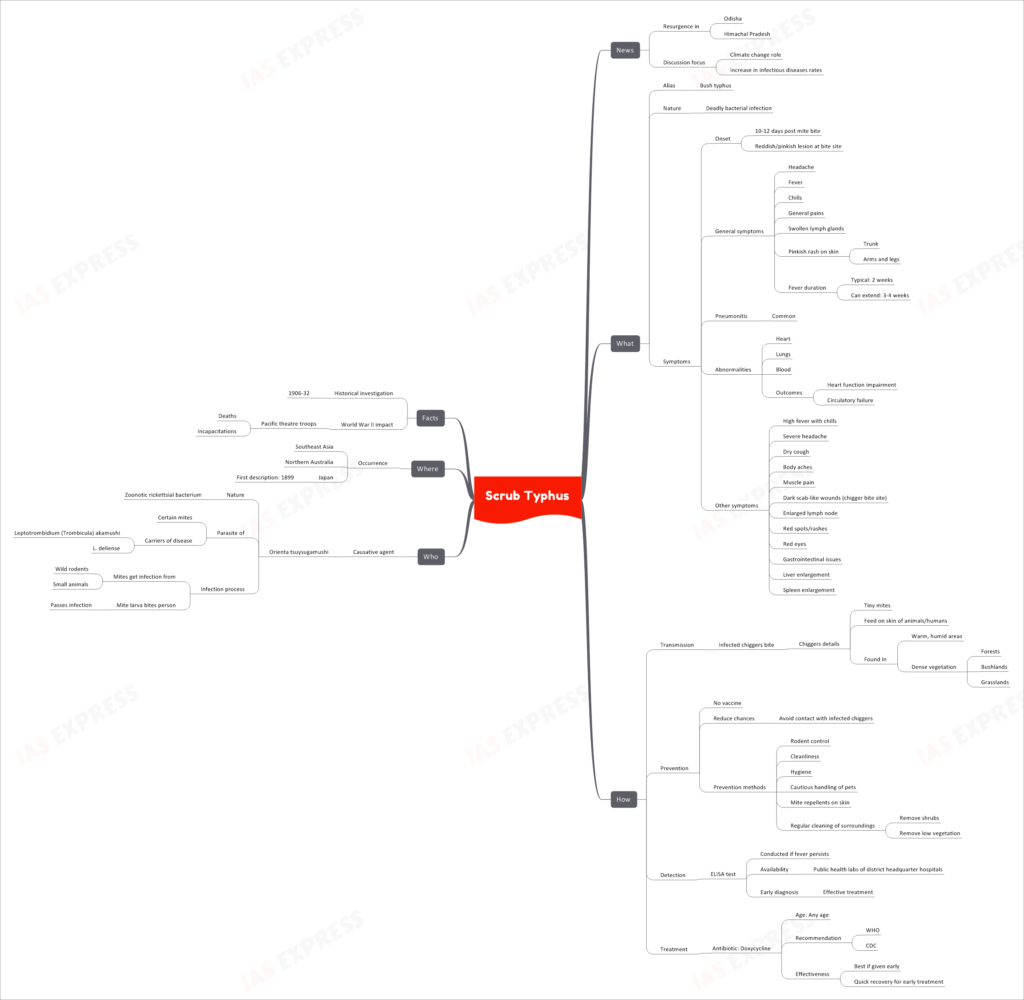Scrub Typhus

Recent reports highlight the resurgence of scrub typhus, also known as bush typhus, in the Indian states of Odisha and Himachal Pradesh. This resurgence has prompted discussions on the role of climate change in the increased rates of infectious diseases.
This topic of “Scrub Typhus” is important from the perspective of the UPSC IAS Examination, which falls under General Studies Portion.
What is Scrub Typhus?
Alias: Scrub typhus is colloquially known as “bush typhus.”
Nature: It is a deadly bacterial infection caused by the zoonotic rickettsial bacterium Orienta tsutsugamushi.
Symptoms
- Onset: Symptoms typically appear 10-12 days after being bitten by an infected mite.
- Lesion at Bite Site: The initial sign is a reddish or pinkish lesion at the site of the mite bite.
- General Symptoms: Patients experience a range of general symptoms, including headache, fever, chills, general pains, swollen lymph glands, and a pinkish rash on the skin, often on the trunk, arms, and legs.
- Fever Duration: The fever associated with scrub typhus typically lasts for two weeks but can extend to 3-4 weeks.
- Pneumonitis: Pneumonitis is a common complication of scrub typhus.
- Abnormalities: The infection can lead to abnormalities in the heart, lungs, and blood, potentially resulting in heart function impairment and circulatory failure.
- Other Symptoms: Other symptoms include high fever with chills, severe headache, dry cough, body aches, muscle pain, dark scab-like wounds at the chigger bite site, enlarged lymph nodes, red spots or rashes, red eyes, gastrointestinal issues, liver enlargement, and spleen enlargement.
How is Scrub Typhus Transmitted?
Transmission
- Infected Chiggers: Scrub typhus is primarily transmitted when infected chiggers bite humans. Chiggers are tiny mites that feed on the skin of animals and humans.
- Chiggers Details: These mites are typically found in warm, humid areas with dense vegetation, including forests, bushlands, and grasslands.
Prevention and Detection
Prevention
- No Vaccine: Currently, there is no vaccine for scrub typhus.
- Reducing Chigger Contact: Prevention involves avoiding contact with infected chiggers.
- Preventative Measures: These include rodent control, maintaining cleanliness and hygiene, cautious handling of pets, applying mite repellents on the skin, and regularly cleaning the surroundings by removing shrubs and low vegetation.
Detection
- ELISA Test: Diagnosis is typically confirmed through an enzyme-linked immunosorbent assay (ELISA) test. This test is conducted if fever persists and is available in public health labs of district headquarter hospitals. Early diagnosis is crucial for effective treatment.
Treatment
- Antibiotic: Doxycycline: Doxycycline is the recommended antibiotic for treating scrub typhus, and it is effective for patients of any age. Both the World Health Organization (WHO) and the Centers for Disease Control and Prevention (CDC) recommend its use.
- Effectiveness: Treatment is most effective when administered early, leading to quicker recovery.
Who is the Causative Agent?
Causative Agent
- Orienta tsutsugamushi: The causative agent of scrub typhus is Orienta tsutsugamushi, a zoonotic rickettsial bacterium.
- Parasite of Mites: It is a parasite of certain mites, including Leptotrombidium (Trombicula) akamushi and L. deliense, which serve as carriers of the disease.
- Infection Process: Mites acquire the infection from wild rodents or small animals. When mite larva bites a person, it passes the infection to the host.
Where Does Scrub Typhus Occur?
Occurrence
- Scrub typhus is commonly found in Southeast Asia, Northern Australia, and Japan.
- It was first described in Japan in 1899.
Historical Facts
Historical Investigation
- Scrub typhus has been under investigation since 1906-32.
World War II Impact
- During World War II, scrub typhus had a significant impact on troops in the Pacific theater, resulting in deaths and incapacitations among soldiers.

